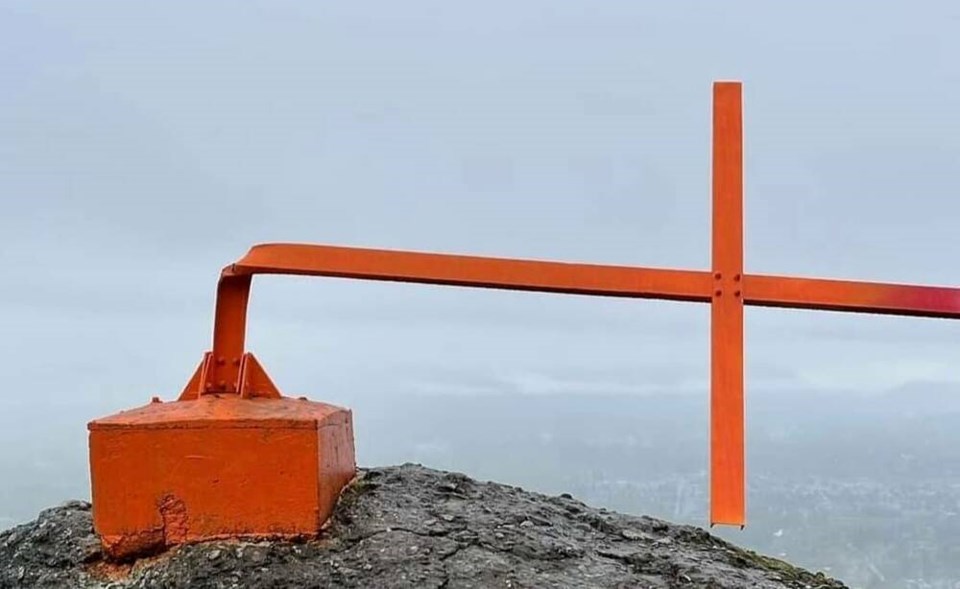The large cross atop Mount Tzouhalem overlooking Cowichan Bay has been vandalized — again.
The metal cross has been bent and twisted at a 90-degree angle and painted orange with the number 215 on the built-up base, a possible reference to the number of unmarked graves found at the Kamloops Residential School.
The Nature Conservancy of Canada, which owns the land on Mount Tzouhalem and the rocky bluff where the cross stands, said Wednesday the cross will be removed.
“Nature Conservancy of Canada is increasingly concerned about the ongoing vandalism at the cross site,” spokeswoman Lesley Marian Neilson said in a statement to the Times Colonist. “We are a land conservation organization that is focused on protecting and restoring natural areas. We are not prepared to accept the liability posed by this contentious public landmark and will be removing it from the site.”
The Chase Woods Nature Preserve on Mount Tzouhalem is in the heart of the Cowichan Tribes’ traditional territory.
The cross has stood there for more than 60 years, but has been repeatedly vandalized, burned or stolen. It has been a polarizing symbol in the Cowichan Valley, where some believe it should stay because of deep religious roots and others want to see it as a symbol of oppression and want it gone.
Larry Pynn, who writes a blog on environmental issues in the Cowichan Valley at sixmountains.ca, said there are Indigenous and non-Indigenous people on both sides of the argument.
The white cross was completely removed in July 2021, without permission of the landowners, but mysteriously reappeared last February.
Later that month, the blog reported that the cross had been painted in rainbow colours, a potential reference to sexual and gender diversity. In March, it said the cross had been painted orange, with the number 215 painted on the rocks nearby.
The cross has a long history in the Cowichan Valley, likely dating from at least the 1960s when it was carried to the mountain and planted on the bluff during Good Friday, replicating the journey of Jesus Christ who carried the cross to his crucifixion.
Cowichan Tribes Chief William Seymour told Glacier Media in February that the cross has had a rough history atop Mount Tzouhalem.
“A wooden cross used to be carried from the stone church and erected every Easter,” Seymour said. “Every year, someone kept knocking it down … sometimes it was just burned.”
A steel cross was bolted into the rock in the 1980s, but it was also toppled several times, either by weather or vandalism.
North Cowichan Mayor Al Siebring said he isn’t commenting on the latest incident with the cross.
“There are folks in the Chowichan Nation who want to keep the cross. There are First Nations [members] on the other side of the fence. And there is the same divide [among non-Indigenous people],” Siebring said. “It’s a no-win for everybody.”
Reaction to the latest damage to the cross was mixed on the Pi’paam (Mt. Tzouhalem) Trail System Facebook page.
“It wouldn’t be the end of the world if it were just removed (cement block included). The view is obscured by it and everyone would stop vandalizing it,” said Samantha S. Elizabeth.
Genevieve Johnny, an elder from Duncan, called the vandalism “heartbreaking.”
“I walked with the elders that put a wooden cross up there … show some respect,” she posted. “Please, God, forgive the person that did this.”
Scott Bannister said: “At a certain point you have to ask why [the cross] is even there. It’s pretty clear it’s not wanted, and it’s not exactly relevant to the local area/history, at least not in a positive way.”



